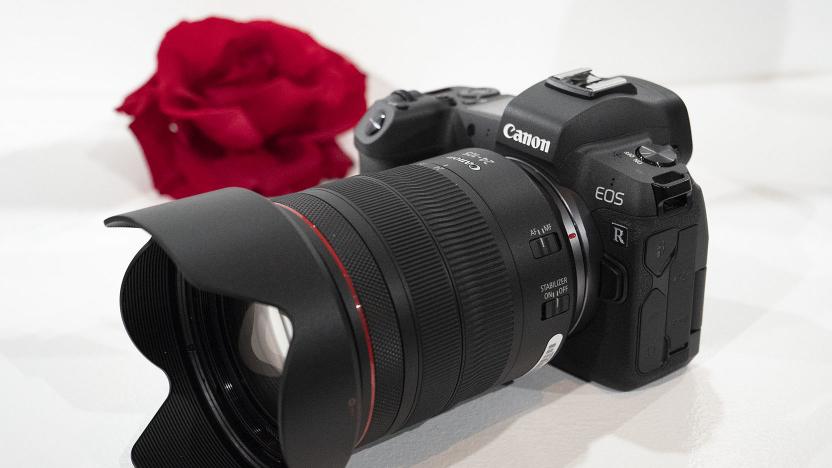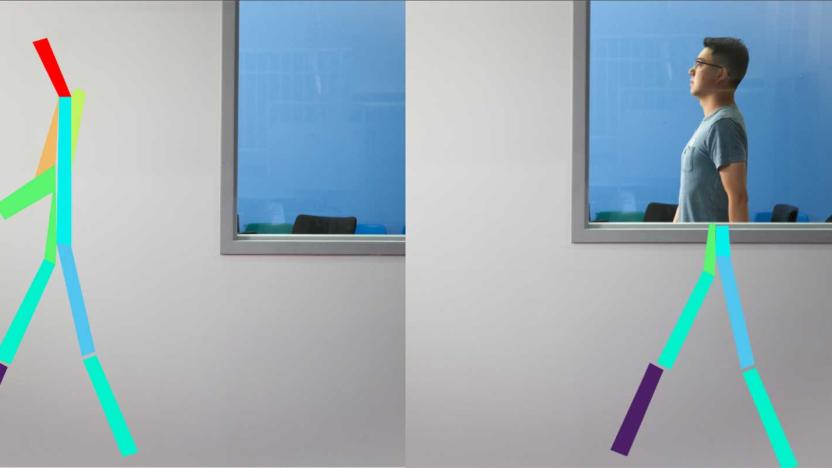RF
Latest

Everything you need to know about Canon’s EOS R mirrorless camera
Canon and Nikon protected their DSLR turf as long as possible, but Sony has been killing them lately with its mirrorless range. Nikon finally jumped into the fray by launching the Z6 and Z7 models, and today, Canon unveiled the $2,299 EOS R, a 30.3-megapixel video-centric full-frame mirrorless camera. It also introduced a new lens mount, Canon RF, along with four lenses, including three interesting high-end "L" models. The EOS R slots between Sony's A7 III and A7R III and the Nikon Z6 and Z7, resolution-wise. It's a near match to Canon's own EOS 5D Mark IV DSLR, with similar resolution, dual-pixel autofocus, shooting speeds and video specifications.

AI detects movement through walls using wireless signals
You don't need exotic radar, infrared or elaborate mesh networks to spot people through walls -- all you need are some easily detectable wireless signals and a dash of AI. Researchers at MIT CSAIL have developed a system (RF-Pose) that uses a neural network to teach RF-equipped devices to sense people's movement and postures behind obstacles. The team trained their AI to recognize human motion in RF by showing it examples of both on-camera movement and signals reflected from people's bodies, helping it understand how the reflections correlate to a given posture. From there, the AI could use wireless alone to estimate someone's movements and represent them using stick figures.

MIT uses radio waves and AI to more accurately study sleep
Sleep tracking has moved to the bedroom, with apps, peripherals and wearables that use movement or your device's microphone to figure out when you're sleeping or awake. Those with sleep disorders, however, are still stuck with large, disruptive arrays of physical sensors for sleep studies. Now, however, researchers at MIT have started using radio signals and artificial intelligence algorithms to analyze patients' sleep stages without physical sensors and they're reporting a high rate of accuracy. This could help people with Parkinson's, Alzheimer's and epilepsy, all of whom can have sleep disruptions that are hard to detect. Eventually, it may help all of us.

Earth's radio signals may be protecting it from space radiation
The Earth's atmosphere bears precious little resemblance to what it looked like at the start of the Industrial Revolution. As radio technology has advanced and spread, the signals that transmitters produce -- specifically the Very Low Frequency (VLF) variety -- have changed the way that the upper atmosphere and the Van Allen Radiation Belts interact, according to a study recently published in the journal Space Science Reviews. In effect, these radio waves may be enveloping the globe like an electromagnetic comforter, protecting it from satellite-frying space radiation.

True wireless charging is almost ready
Three years running, I've visited Energous at CES to be pitched on its wireless vision for the future of charging. This time, things are a little different. It's not announcing a manufacturing milestone or touting independent verification of its WattUp charging tech. Instead, it's actually launching some products. If you've never heard of Energous, it's a startup that uses RF to charge devices at a distance. There are a few different types of transmitters, but the basic tech involves a WattUp charging station sending out RF waves in a focused beam toward a compatible device. A chip in the gadget then converts the waves into direct-current electricity. This "rectification" process isn't new, but Energous' claim is it's able to do it efficiently enough to make sense for charging small devices like wearables and phones. In the long run, Energous will offer wireless charging at 15 feet. For the first batch of products, though, it's the less-impressive microsolution -- capable of charging at a distance of just a few inches. It's basically a replacement to the wireless charging you'll find on existing wearables, but with a few benefits.

Hot Wheels AI is the love child of slot cars and Roomba
Model cars and track racing are the bread and butter of Hot Wheels, but they might look a little long in the tooth compared with flashy console games like Gran Turismo and Need for Speed. With the new Hot Wheels AI set, toy autos get a bit of a boost -- not just in speed, but in intelligence. Now you can race against a computer in the real world, right there on your living room rug.

Wireless charging tech harvests your phone's wasted radio waves
When you think of wireless charging, you probably think of special charging pads for your phone. But what if your phone could partly charge itself? Radient Micro-Tech claims to have managed just that. It just received two patents for technology that reportedly captures energy from a device's wasted radio waves (those that would merely dissipate in the air) for the sake of charging. While it's not specific about how the technology works, it would harvest those RF waves through antennas built into your phone's screen. Radient is claiming that you'd get up to 30 percent longer battery life, which could be enough to get you through a particularly active day.

Disney's smart toys combine Avengers, sensors and imagination
Those giant, green Hulk hands in your closet might be cool but their utility doesn't extend much beyond freaking out your cat and making tired "you wouldn't like me when I'm angry" jokes. Disney has an idea to remedy that with internet-connected versions of those as well as a pair of Iron Man gauntlets. Wait, smart toys? Yep. As The Wall Street Journal tells it, these Playmation devices will work in concert, via radio frequency and infrared signals, with special action figures as well as other branded apparatus you strap on to your body. Based on what TechCrunch says, these sound an awful lot like a home laser-tag set. Different playthings offer different augmentations (action figures come with new, narrated, playable stories, and you can buy more of the latter via a connected app) but they won't all work together.

This router can power your devices wirelessly from 15 feet away
Wireless charging hasn't really set the world on fire. Since the Palm Pre first introduced us to the idea at CES 2009, a few companies have added similar functionality to their phones and smartwatches. Power without wires is undoubtedly useful, but none of the solutions have ever set our devices free from a charging pad, which is tantamount to plugging them in, really. Energous is one of a handful of companies hoping to change that. It claims its technology can charge your phone and wearable from up to 15 feet away, no wires required.

Blumoo turns mobile devices into RF remotes, streams music via Bluetooth (video)
If you hoard gadgets like us, then your living room is probably covered with a plethora of remote controls. Flyover Innovations' Indiegogo campaign aims to streamline your home audio experience and minimize your mess with Blumoo, a small hardware platform that turns your mobile device into an RF remote. The IR-equipped Blumoo pod connects to your stereo via standard 3.5 mm jack or RCA connections, and allows you to control your home theater system with your mobile device through the magic of Bluetooth. The Blumoo app -- coming soon for both iOS and Android -- pulls from a database that Flyover claims is comprehensive enough to ensure your home theater equipment is covered. Flyover plans on retailing the device for $79 but is offering an early bird special for supporters starting at $45. To check out their rewards and watch their cartoon mascot, Blumoo Bob, shake it a like a polaroid picture, head over to their Indiegogo page. For a more informative -- if slightly less entertaining -- video, watch the preview after the break.

Phi: a wireless re-routing card that puts you in control of the airwaves (video)
For all the talk of convergence in mobile devices, there's relatively little chatter about the coming together of wireless signals themselves. In other words, why should we have a separate device to interact with each type of wireless signal? And so, with that intriguing question, begins the pitch for a new device call Phi. It's a $750 antennae-laden PCIe card that slots into a desktop and gathers up wireless signals that are flying around the home -- so long as they have a frequency below 4GHz and don't involve bank-busting neutrinos. The card then allows custom apps to re-direct those transmissions as you like: potentially acting as a "base station" so you can make free calls from your cell phone, or receiving over-the-air HD transmissions which you can play on your tablet, or doing whatever else hobbyists and devs can cook up. Phi is still version 0.1 and Linux-only while the startup behind it -- Per Vices -- looks for a Kinect-style blossoming of third-party interest, but with nothing less than a deity-like command over the domestic ether on offer, how could it ever fail?

Intel puts CPU and WiFi radio together on same chip, with proper shielding of course
It's little notches like these that could eventually carve out a big Intel-shaped niche in the mobile universe. What you're looking at is a prototype chip codenamed 'Rosepoint' that somehow crams a digital WiFi radio and a dual-core Atom CPU onto the same piece of silicon. Interference would normally make such proximity impossible, but Rosepoint incorporates new anti-radiation and noise-cancelling shielding to prevent the components from corrupting each other. The aim isn't just to shrink everything, but also to deliver "state of the art power efficiency" by removing unnecessary circuitry. Intel even claims it can fit the RF antenna onto a chip too, but it doesn't want to show that off just yet. Too many prying eyes.

Turtle Beach expands its wireless headset lineup, intros XP400 with adjustable surround sound, stereo XP300
If you'll recall, along with its pre-CES unveiling of new gaming and lifestyle headsets, Turtle Beach promised a bigger "surprise announcement" for day one of the show here in Vegas. Well, it's just spilled the beans on an impressive new duo of Xbox-oriented (and PlayStation compatible) Ear Force wireless gaming headsets. Meet the XP400 with Dolby 5.1 virtual surround sound and the identical, but stereo, XP300. We're told that they're essentially the younger siblings of the company's PX5-rooted XP500, featuring a similar design with totally wireless connection to the Xbox 360 (thanks to TB's Xbox Chat Adapter), and a dual-pairing Bluetooth radio for taking calls while gaming. Furthermore, both headsets actually improve upon the XP500's, in a few key areas including: better button placement on the earcups, a new 2.4/5GHz dual-band WiFi 2.4GHz transmitter to avoid interference from nearby wireless devices and an included 15-hour rechargeable battery so you won't be hunting for AAAs. While both headsets feature customizable EQs, the XP400 steps things up from the XP300 with tweakable Dolby 5.1 simulated surround sound, thanks to some special work on Turtle Beach's end. Notably, it's the first headset from Turtle with the ability, dubbed "adjustable surround sound angles," and it means you'll now be able to customize the placement of the virtual speakers to your preference, rather than being stuck to Dolby Headphone's usual preset parameters. Both headsets will be available in earlier 2012, with the XP400 priced at $220 and the XP300 at 50 bucks less. If you'd like the full rundown of specs and features, you'd best check out the press release we've kindly embedded just past the break.

Encrypted Text: A savvy rogue's guide to the Fall of Deathwing via the Raid Finder
Every week, WoW Insider brings you Encrypted Text for assassination, combat and subtlety rogues. Chase Christian will be your guide to the world of shadows every Wednesday. Feel free to email me with any questions or article suggestions you'd like to see covered here. The first half of the Dragon Soul raid consists of knocking out a few of Deathwing's commanders that are attacking Wyrmrest Temple. After toppling the first four bosses of Dragon Soul, we finally see Deathwing face-to-face at the peak of the temple. He's still too busy to attack us himself, instead sending a couple of his additional underlings our way. Our first challenge will be overcoming Ultraxion, Deathwing's favorite twilight dragon. He's an easy target for rogues and is just about as simple for us as Warlord Zon'ozz. After that, we board an airship to face Warmaster Blackhorn and his Twilight infantry. Finally, we confront Deathwing in two separate encounters, each with its own challenges. We fight Ultraxion from the roof of Wyrmrest Temple, as he's too massive to fit inside. He'll spend most of the encounter cleaving the entire raid, which makes Feint an amazing tool here. Use it on cooldown for the entire fight. Unfortunately for rogues, we're not able to get behind Ultraxion, due to his positioning over the ledge of the temple roof. While Ultraxion has a buff that prevents him from parrying our frontal attacks, we're not able to use any positional attacks like Backstab or Ambush.

Inside Secure announces NFC chips to help distinguish knockoffs from the real thing
If you can't tell if a Rolex or a knockoff Prada bag is fake, your NFC-enabled smartphone will be able to. Toking on a long-standing problem with counterfeiting, French company Inside Secure has released the Vault150 security module, a NFC-based chip that can be embedded into any product a retailer might wish to have authenticated by prospective buyers. This could become as easy as literally embedding the chip, as NFC chips require no power source, can collect RF energy from an NFC reader such as a smartphone and complete an authentication request for a potential buyer. For more intricate products where the chip might have to be buried deeper, Inside Secure has also offered several antenna options that allow the chip to be placed well within an item and still communicate with an NFC reader. In cases where a module needs to be embedded in items like a bottle of wine or pair of shoes, the chip can use a slew of voltage, frequency or temperature change sensors to sense if someone has tried to alter the chip's information and return a warning from there. Along with authentication purposes, the devices could also ping a shopper's handset (in addition to doing cool things like opening doors) when they came within a certain range of a product, informing them as to the savings they might be about to pass by. Final pricing and availability has yet to be announced and there's no guarantee that this will spot every fake, but it'll probably be better at the task than the current champ (yes, Chumlee).

Optoma delivers three new projectors, one does 3D for just $1,499
We've said it before and we'll say it again -- you deserve a projector. Watch those tiny LCDs and plasmas if you want, but it's time to go big or go home and Optoma is delivering three new beamers to help that happen. The new HD33 model (pictured above) makes its claim to fame as the first 1080p 3D projector available for less than $1,500, while the HD3300 and HD8300 make their bones in slighly more upmarket segments, priced at $1,999 and $4,499, respectively. All three make 3D happen in conjunction with the company's new RF-synced active shutter glasses, while featuring PureMotion3D and PureDepth for frame interpolation and brightness control. Those extra bucks spent on the HD8300 has ISF certified controls, lens shift for extra placement flexibility, PureMotion4D motion interpolation and a lamp rated at 1,500 lumens. The HD33 is available now, while the other two are expected to start shipping later this month, however with CEDIA 2011 just around the corner we'd probably hold off on pressing the buy button before everyone shows off their latest home theater wares.

Visualized: this gel-filled Sprint head is testing all sorts of futurephones
Chamber testing is most certainly nothing new for your average carrier -- every one of the big boys here in the States already does something similar to this -- but it's not often that we're given an inside look at what exactly happens within those elusive doors. During a recent Sprint campus walkthrough, we peeked into the carrier's network development lab for a glimpse at what it takes to certify a phone for use on its network. Granted, the vast majority of Sprint's testing is done elsewhere across the industry, and we were informed that the yellow dome shown above is actually a minty fresh model that includes "gel" within its borders, seemingly to produce a more realistic testing ground. You know -- because human brains are clearly shrinking, while craniums are being increasingly filled with nondescript fluids. All jesting aside, we were told that this is the place where Sprint ensures Antennagate never comes to its side of town, and every Now Network phone (present and future) has to roll through here before being allowed out. The reason? Sprint needs to be absolutely certain that there's no stray radio emissions bleeding into frequencies that it doesn't support, and of course, to ask the Verizon guy if he can hear him now. %Gallery-128959%

D-Link brings the Boxee Box remote to PC, Mac users
Boxee users on PC and Mac should no longer feel ignored, with promises of updated software on the way and now the option to use a Boxee Box remote from D-Link. The two sided QWERTY design is unchanged and the included RF dongle means your HTPC can stay safely out of sight while you enjoy some branded remote control action without selling out for a one-size-fits-all box. The roll your own media player crowd can pick up the remote at a penny under $50 at a variety of online retailers right now, the long awaited software update is still due this fall.

EFO's diminutive Google TV keyboard makes us laugh, cry, exclaim
Google's remained fairly mum on its TV experiment ever since a number of major networks blocked Google TV devices from accessing their online content, but you can bet that Logitech and Sony are still doing everything they can to unload inventory. If -- for whatever reason -- you've found yourself in the precarious position of needing a backup keyboard, EFO's got a couple of comical solutions. The outfit's new Google TV keyboard is named simply enough, and it's also one of the smallest KB remotes in the history of KB remotes. That's great for those who tend to shove their controlling devices into pockets and whatnot, and there's even a touchpad that works vertically and horizontally -- depending on preference, of course. Bluetooth ($75) and RF ($65) versions are available, with initial shipments to go out starting on the 15th. Head on past the break for a demo video, also known as the cutest thing you'll see all day.

TiaLinx's Cougar20-H surveillance robot can peer through walls, see you breathe
You may be able to outrun it, but you probably won't be able to hide from TiaLinx's new Cougar20-H surveillance robot. While it might not look like much, the bot packs an impressive RF array that's not only able to detect movement within a building (though concrete walls, no less), but is even able to detect a person breathing inside a building at "long standoff distances." Perhaps not surprisingly, complete details are largely being kept under wraps (the bot was developed with some help from the U.S. Army), but this isn't simply a prototype -- it'll be rolling out next month and is expected to be put to use byvarious law enforcement and government agencies. Head on past the break for the official press release.













